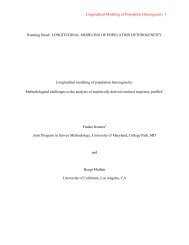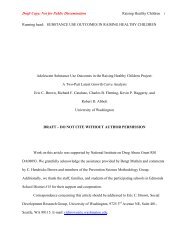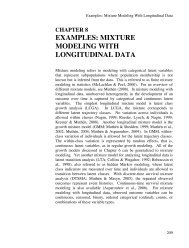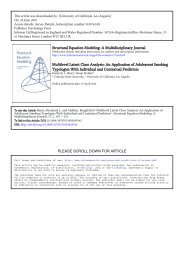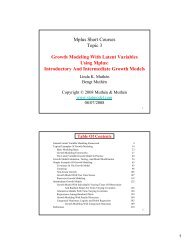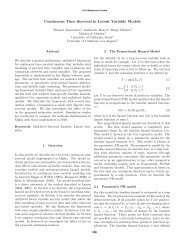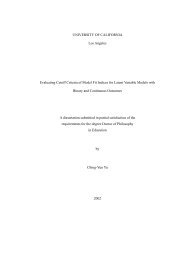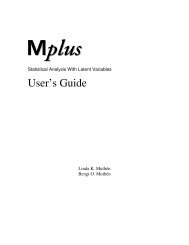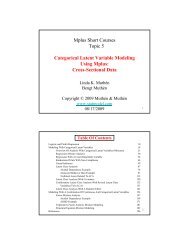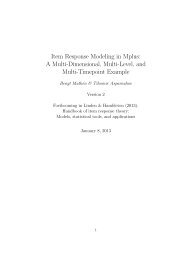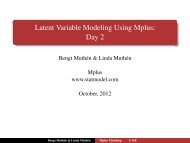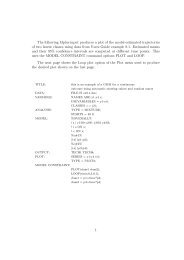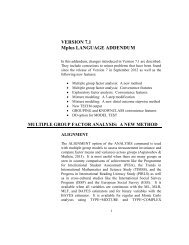Here - Mplus
Here - Mplus
Here - Mplus
Create successful ePaper yourself
Turn your PDF publications into a flip-book with our unique Google optimized e-Paper software.
Computing the Strictly PositiveSatorra-Bentler Chi-Square Test in <strong>Mplus</strong>Tihomir Asparouhov and Bengt Muthén<strong>Mplus</strong> Web Notes: No. 12April 17, 20131
1 IntroductionIn this note we illustrate with several examples how to compute the strictlypositive robust chi-square test described in Satorra and Bentler (2010). Thisrobust chi-square can be used as an alternative to the robust chi-square proposedin Satorra and Bentler (2001) which can sometimes produce negativetest statistics due to its asymptotic nature. We will illustrate this computationusing a simple factor analysis model estimated with the MLR estimatorin <strong>Mplus</strong>. Suppose that we have a model M 1 and and a more restrictedmodel M 0 . We denote by F i the robust test of fit for model M i , by L i thelog-likelihood value for model M i , by c i the correction factor for F i , by b i thecorrection factor for L i , d i the degrees of freedom for F i , and p i the numberof parameters in model M i . All of these quantities can be easily foundin the <strong>Mplus</strong> output. In <strong>Mplus</strong> the standard robust chi-square for testingM 0 against M 1 can be computed in two different ways, using the test of fitand its correction factor, or using the log-likelihood and its correction factor.The two lead to the same result. One of the advantages of the log-likelihoodapproach is that it does not require the existence of a test of fit and it can beused for any pair of nested models. Using the test of fit the robust chi-squarefor testing M 0 against M 1 is computed as followsF = (F 0c 0 − F 1 c 1 )(d 0 − d 1 )c 0 d 0 − c 1 d 1(1)Using the log-likelihood values the robust chi-square for testing M 0 againstM 1 is computed as followsF = 2(L 1 − L 0 )(p 1 − p 0 )b 1 p 1 − b 0 p 0(2)Both versions produce exactly the same result (up to a round off error). ThequantityF 0 c 0 − F 1 c 1 = 2(L 1 − L 0 )is the unadjusted chi-square statistic whilec 0 d 0 − c 1 d 1d 0 − d 1= b 1p 1 − b 0 p 0p 1 − p 0(3)is the correction factor for testing M 0 against M 1 . In the above formulas thenumerators are guaranteed to be positive however the denominators are not,2
i.e., in all applications we haveF 0 c 0 > F 1 c 1L 1 > L 0d 0 > d 1p 1 > p 0but in some applications the asymptotic inequalitiesc 0 d 0 > c 1 d 1b 1 p 1 > b 0 p 0will not hold. To avoid this problem the Satorra and Bentler (2010) use a newtest of fit correction factor c 10 or a likelihood correction factor b 10 which areobtained from a model M 10 . This model M 10 can be viewed as unoptimizedM 1 model having the M 0 parameter estimates. More specifically the modelM 10 is the same as the M 1 model except that its parameter estimates havenot been optimized to convergence but instead its parameter estimates arethose of the M 0 model. In addition the log-likelihood value of M 10 is thesame as that of M 0 . With these quantities the new Satorra and Bentler(2010) chi-square is computed as followsor equivalently using the log-likelihood valuesF ∗ = (F 0c 0 − F 1 c 1 )(d 0 − d 1 )c 0 d 0 − c 10 d 1(4)F ∗ = 2(L 1 − L 0 )(p 1 − p 0 )b 10 p 1 − b 0 p 0, (5)where c 10 and b 10 are the correction factors obtained from the model M 10estimation while all other quantities are as in formulas (1) and (2). In thisimproved version the denominators are guaranteed to be positive, i.e.,c 0 d 0 > c 10 d 1b 10 p 1 > b 0 p 0not just asymptotically but also for small sample sizes.3
It is important to focus not just on the fact that the new test has a positivevalue, but what really is at stake is the quality of the results measured by thetype I error of the test and the power of the test. These issues are howeverbeyond the scope of this note. We can just mention that alternative testssuch as those obtained with the estimators BAYES, MLM, MLMV, WLSM,WLSMV, ULSMV, could actually yield more accurate results than both thenew and the regular Satorra-Bentler tests. All of these test statistics aresolid asymptotically however there is little guidance for small sample sizesituations. Usually a simulation study can reveal the quality of the resultsin small sample size cases.The new Satorra-Bentler test should be used instead of the traditionalversion when the test statistic is negative. However, there are probably othersituations when the new version should be used. For example when thecorrection factor (3) is very small (almost negative) we should probably beusing the new version as well. This line of arguments leads to the problem ofwhen to actually compute the new SB test statistic. More research is neededto answer this question.2 Example 1Consider the factor analysis model with 5 indicator variables and 1 latentfactorY j = ν j + λ j η + ε jwhere Y j for j = 1, ..., 5 are the observed variables, η is an unobserved normallydistributed latent variable, ε j are zero mean normally distributed residualswith a variance covariance Θ. For identification purposes λ 1 = 1. Inmodel M 0 we estimate the following parameters: 5 parameters ν j , j = 1, ..., 5;4 loading parameters λ j , j = 2, ..., 5; the variance of η parameter ψ, the 5residual variance parameters θ jj , j = 1, ..., 5; and a residual covariance parameterθ 12 for a total of 16 parameters. In model M 1 in addition to theM 0 parameters we estimate the residual covariance θ 23 . The results of theM 0 and M 1 estimation using a data set with 50 non-normal observations arepresented in Table 1. Now using formula (1) we get that F = −1.420. Usingformula (2) we get F = −1.435. The small difference between the two versionsis due to the round off error in the values that <strong>Mplus</strong> reports (up to thethird digit after the decimal point). Thus this example illustrates the problemswith the standard robust chi-square which leads to a negative value.4
Table 1: Results for models M 0 and M 1 .Model M 0 M 1Test of fit F i 18.902 7.301Degrees of freedom d i 4 3Correction factor for test of fit c i 0.515 1.095Log-likelihood L i -250.888 -250.015Number of estimated parameters p i 16 17Correction factor for log-likelihood b i 1.843 1.663In contrast, when we estimate M 10 we obtain c 10 = 0.034 and b 10 = 1.850and when we use the new chi-square F ∗ using formula (4) we get F ∗ = 0.889and using formula (5) we get F ∗ = 0.890. Again the small difference is dueto the round off error. Our illustration confirms that the test statistic F ∗yields positive values. This result is also close to the T-value test statisticbased on the robust standard errors for the additional parameter ψ 23 :(T − value) 2 = (0.823) 2 = 0.677.3 Practical Aspects of the EstimationThe main issue in the estimation is how to construct an <strong>Mplus</strong> run that yieldsthe correction factors c 10 and b 10 . The first step in doing so is actually inthe estimation of model M 0 . Using the SVALUES option of the OUTPUTcommand we obtain the model M 10 written in the <strong>Mplus</strong> language. Copyand paste that model specification into the input file used for the M 1 estimation.You will need to add the command for the extra parameters inmodel M 1 , in our example that is the command Y 2 W IT H Y3 ∗ 0; which sets astarting value for the θ 23 parameter. Once we have this model setup for M 10we need to make <strong>Mplus</strong> estimate all quantities with 0 iterations, i.e., for thisexact same parameters. This is achieved by specifying the option CONVER-GENCE=100000000 in the ANALYSIS command 1 . This option specifies the1 For some models the command that accomplishes this is MITER=1. These are themodels that are estimated with the EM algorithm such as mixture models and models thatrequire numerical integration. Both options can be used if it is not clear which option is appropriate.Alternatively, the commands MCONVERGENCE=100000000; ALGO=ODLL;5
convergence criterion in <strong>Mplus</strong> which is typically 0.00005. The result of thiscommand is that in the very first attempt to optimize the parameters, thelog-likelihood derivatives will be computed and will be compared against theconvergence value. Because the convergence value is so large <strong>Mplus</strong> will concludethat convergence has already been achieved and that the parametersare optimized. Then <strong>Mplus</strong> will provide the needed output which includesthe correction factors c 10 and b 10 . When running the model M 10 includethe TECH5 option of the OUTPUT command. This option will show alliterations that have been taken. We want to make sure that no iterationsare taken in that run. Usually there are some iterations in that run withthe heading ”TECHNICAL OUTPUT FROM EM ALGORITHM ITERA-TIONS FOR THE H1 MODEL”. Those iterations do not count as theyare used for computing the sample statistics. You should expect to see noiterations in the sections ”ITERATIONS USING GRADIENT” and ”ITER-ATIONS USING QUASI-NEWTON”. In addition one should check that thelog-likelihood value of the M 10 model is the same as that for the M 0 model.Finally we want to point out that the example we presented here is abit simpler than the examples used in practical situations such as tests ofinvariance and tests of partial invariance. In such more complicated examplesadditional steps may be necessary to specify the model M 10 . The basicdefinition of this model is that it has the parameterization of M 1 , i.e., isparameterized as an M 1 model and it has the same number of parametersas the M 1 model but it has the same log-likelihood value as the M 0 model.The model M 10 always exists. Its existence is guaranteed by the fact thatM 0 is nested within M 1 . To construct the M 10 model one simply needs tounderstand how and why exactly M 0 is nested within M 1 . Three furtherexamples of how to construct M 10 are given in Sections 4 - 6.The input files for the three models used in this example are presentedbelow in Appendix A.4 Example 2In certain cases the robust test of fit itself, that is, the test against a completelyunrestricted model, will have the problem of negative chi-square valcanbe used for this estimation. The OUTPUT options TECH5 and TECH8 can be usedto verify that the parameter estimates are not altered and no maximization iterationsoccur.6
ues. Consider as an example the same model as in Example 1 with addedresidual covariance parameters θ 12 , θ 23 , θ 45 , θ 15 . <strong>Here</strong> the model M 1 is theunrestricted mean and variance model. The test of fit for this model yieldsa negative value. To construct the M 10 model in this case we can use theRESIDUAL option of the OUTPUT command to obtain the estimated meanand variance covariance for the observed variables Y j for the M 0 model. Tosetup M 10 we setup an unrestricted model for Y j where all means, varianceand covariance starting values are set at the estimated quantities from theM 0 model. In this situation only formula (5) can be used. From the 3 runswe get L 0 = −249.800, L 1 = −246.017, b 0 = 1.721, b 1 = 1.644, p 0 = 19 andp 1 = 20. Using (5) we get the test of fit value F ∗ = 41.801.5 Example 3In some cases the construction of M 10 involves non-standard approaches becausethe difference between M 0 and M 1 is not as simple as having an additionalparameters in M 1 . Consider as an example a factor analysis modelas in Example 1, without any residual correlations, but conducted as a twogroup model. The standard setup for this M 0 model is that the the residualvariances for the observed variables and the factor variance are groupspecific, the observed variable intercepts are group invariant as well as theloading parameters, and the factor mean is estimated as a free parameter inthe second group. Suppose that we need to test the loading invariance acrossthe two groups, i.e., we consider the more flexible model where the loadingsare not held equal across the two groups. To construct the M 10 model inthis case we simply need to use the SVALUES option of the OUTPUT commandin the M 0 estimation, copy and paste this model in the M 1 input fileand remove the parameter labels that hold the loadings equal across the twogroups.6 Example 4In some cases the construction of M 10 involves actual computations that revealhow exactly the M 0 model is nested within the M 1 model. Consider forexample the M 0 model we used in the previous section and the M 1 modelwhich has varying across group observed variables intercepts, which necessar-7
ily eliminates also the factor means from the second group for identificationpurposes. To construct the M 10 model in this case we use both the SVAL-UES and RESIDUAL options of the OUTPUT command in the M 0 modelestimation. The M 10 construction is started with the model produced bySVALUES but we modify it in three steps. Step 1 would be to fix the factormean in the second group to 0. Step 2 is to remove the equality labels inthe two groups for the intercept parameters. Step 3 is to replace the startingvalues for the intercept parameters in the second group with the estimatedvalues found in the RESIDUAL output in the M 0 model estimation. Thisexample illustrates how quickly the complexity of the construction of theM 10 model can escalate. In many cases the values that are needed will notbe available in the RESIDUAL output, for example if there is a covariate inthe above model.8
7 Appendix A: <strong>Mplus</strong> input for example 1Inputs for the other examples are available athttp:\\www.statmodel.com\examples\webnote.shtml # web12title: M0 modelvariable: names are y1-y5;data: file=1.dat;analysis: estimator=mlr;model: f1 by y1-y5; y1 with y2;output: svalues;9
title: M1 modelvariable: names are y1-y5;data: file=1.dat;analysis: estimator=mlr;model: f1 by y1-y5; y1 with y2; y3 with y2;10
title: M10 modelvariable: names are y1-y5;data: file=1.dat;analysis: estimator=mlr; convergence=100000000;model: y3 WITH y2*0;f1 BY y1@1;f1 BY y2*0.599;f1 BY y3*0.814;f1 BY y4*0.893;f1 BY y5*0.818;y1 WITH y2*-0.031;[ y1*0.280 ];[ y2*0.380 ];[ y3*0.400 ];[ y4*0.420 ];[ y5*0.420 ];y1*0.167;y2*0.337;y3*0.378;y4*0.385;y5*0.420;f1*0.274;output: tech5;11
References[1] Satorra, A., & Bentler, P.M. (2010) EnsuringPositiveness of the Scaled Difference ChisquareTest Statistic. Psychometrika, 75, 243-248.http:\\www.springerlink.com\content\k716217434q71737\fulltext.pdf[2] Satorra, A., & Bentler, P.M. (2001). A scaled difference chisquaretest statistic for moment structure analysis. Psychometrika,66, 507-514.12



